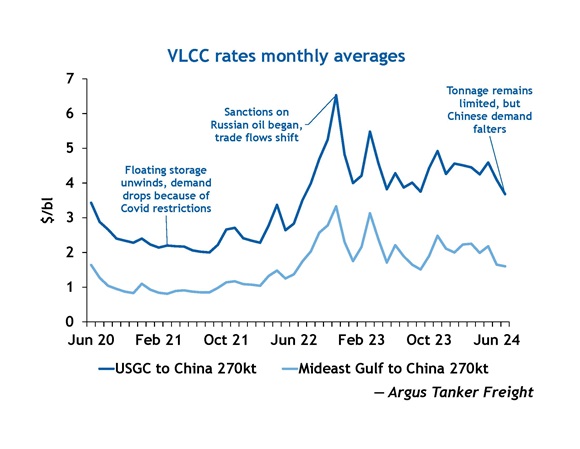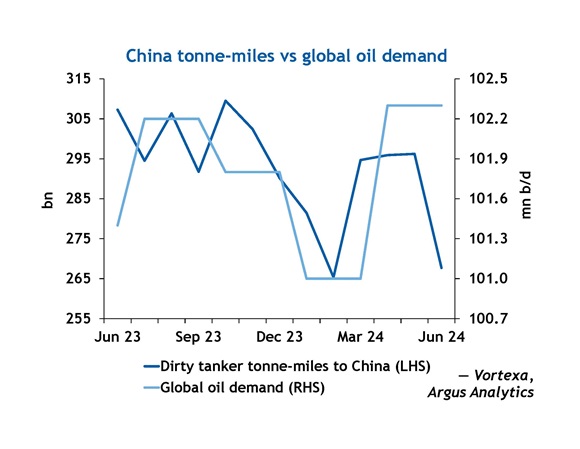Ship operators’ hopes that rates for very large crude carriers (VLCCs) would continue to rise later this summer may have been dashed by sluggish crude demand in China.
A combination of a shift in crude oil flows that began following western sanctions on Russian energy exports in 2022 and limited tanker supply boosted tanker rates, including VLCC rates, to multi-year highs in 2022. But fast forward to 2024, and the rally appears to be slowing.

Dirty tanker demand for shipments into China, the world's largest crude oil importer, fell to 266bn tonne miles in June, its lowest level since September 2022, according to data from Vortexa, before the country lifted Covid-19 restrictions that were crimping its economy. In that period, strong oil demand in other economies and shifted trade flows have increased global dirty tanker demand by 2.9pc to 898bn tonne miles.

Weak demand for China-bound VLCC voyages, which account for about three-quarters of the country's waterborne crude imports, has helped pull VLCC rates to their lowest levels since September 2023. In July, the Mideast Gulf-China VLCC rate for Arab Light cargoes averaged $1.60/bl, down by 16pc year over year, and the US Gulf coast-China VLCC rate for WTI crude averaged $3.67/bl, down by 5pc year over year.
While Covid restrictions are largely a thing of the past, woes in China’s real estate sector have taken their place as a drag on the economy. Decelerated construction activity is curtailing Chinese diesel demand and causing Shandong province independent refiners to lower throughputs, which partially explains sluggish crude deliveries to the country's terminals. China's GDP growth slowed to 4.7pc in the second quarter and in April the country's refiners cut crude runs to a four-month low of 14.31mn b/d.
Aframax, Suezmax earnings edging out VLCCs
The high share of Chinese crude imports that arrive on VLCCs makes the 2mn bl tankers more sensitive to fluctuations in the Chinese economy compared to the two other major crude tanker segments: Suezmaxes and Aframaxes. In July 2024, average shipowner earnings for VLCCs on the US Gulf coast-China route are about $25,400/d, down year over year by 19pc, while Suezmax earnings on the US Gulf coast-Europe route are up by 8pc to $30,500/d . Aframax earnings on the US Gulf coast-Europe route are about flat at $24,500/d. Longer-haul routes for Suezmaxes and Aframaxes from shifted trade flows and Houthi attacks in and around the Red Sea have also played a role in the relative earnings strength of the smaller vessels compared to VLCCs.
Despite recent rate declines, VLCC rates remain well above the troughs experienced in 2021 when the Covid-19 pandemic hamstrung economies and demand for oil — and its transportation — fell. Mideast Gulf-China and US Gulf coast-China VLCC rates are up by 85pc and 83pc, respectively, from their July 2021 levels.
Minimal VLCC deliveries keep market tight
A major reason for the high floor in rates is slowing tanker fleet growth as shipyards were largely occupied with building containerships in the last couple of years. The roughly 900-ship VLCC fleet is expected to add only one VLCC this year, marking the lowest yearly total since the mid-1980s, according to data from shipbroker Affinity. In 2023, shipyards delivered 22 VLCCs into the market, the lowest total since 2015.
While VLCC orders have picked up this year as shipyard capacity opened up and shipowners eyed higher rates down the line, VLCC supply will remain tight into 2025 as shipyards build the new tankers. This tightness is likely to keep the floor for VLCC rates relatively high and prevent rates from falling to their 2021 levels later this year. But the decline in rates this year shows that supply is not so tight as to insulate the VLCC market from the effects of flagging Chinese crude import demand.
By Nicholas Watt


